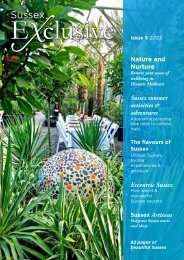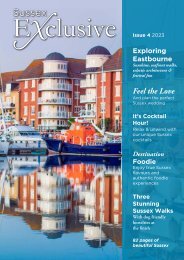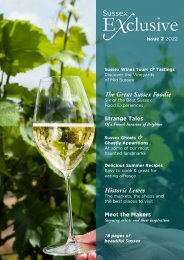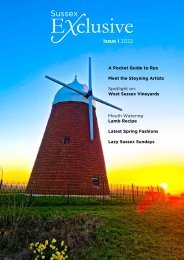Sussex Exclusive Magazine. Issue 7
A delightful dive into the very best Sussex has to offer. Enjoy 48 hours in Chichester and Rother exploring vineyards, castles and Medieval towns, try fantastic local cuisine and foodie experiences, discover ancient bluebell woods and wild garlic, learn the best places to go bargain hunting or visit one of the county's legendary landmarks. From the weird and the wonderful to the sublime and luxury, enjoy 96 pages about one of the most beautiful and bountiful county's in England.
A delightful dive into the very best Sussex has to offer. Enjoy 48 hours in Chichester and Rother exploring vineyards, castles and Medieval towns, try fantastic local cuisine and foodie experiences, discover ancient bluebell woods and wild garlic, learn the best places to go bargain hunting or visit one of the county's legendary landmarks. From the weird and the wonderful to the sublime and luxury, enjoy 96 pages about one of the most beautiful and bountiful county's in England.
Create successful ePaper yourself
Turn your PDF publications into a flip-book with our unique Google optimized e-Paper software.
FOOD<br />
FOOD<br />
Wild garlic &<br />
lemon butter<br />
Wild garlic is abundant at this<br />
time of year and can be found<br />
on damp verges and woodlands<br />
throughout the countryside.<br />
Best picked while it is still<br />
young, as the season progresses from February to<br />
June the leaves become slightly tougher and stronger<br />
in flavour. Add a few leaves to stir fries and stews or<br />
make this fabulous garlic butter. We love it melted<br />
over fresh pasta, spread over some crusty baguette<br />
with some fresh prawns or, best of all, served on top<br />
of a lovely steak and chips!<br />
There are a few rules to remember when foraging;<br />
only take as much as you need and try to spread<br />
out your picking so you don’t deplete just one area.<br />
Avoid areas of high traffic pollution and always<br />
harvest away from areas where dogs might have been<br />
active. Lastly, accurate identification is essential,<br />
especially when it comes to poisonous plants,<br />
fungi and berries; there are many apps and online<br />
resources available to help make sure you are picking<br />
the right thing, and a weekend foraging course is<br />
always a fun and educational experience.<br />
In terms of identification, you know you’ve got<br />
the right plant by the strong odour of garlic when<br />
harvested (the only things you might mistake it for<br />
are lords and ladies or lily of the valley). Both of<br />
these plants are toxic but don’t have that obvious<br />
fragrance when picked, so double check with a good<br />
foraging book before you head out!<br />
The leaves will last for a good week if placed in a<br />
glass of water and stored in the fridge door.<br />
Becci is winner of<br />
F:entrepreneur100, BT's Best<br />
Home Business of the Year and<br />
Remote Worker Awards and The<br />
Mumpreneur 100. You can find her<br />
at Hygge Style<br />
40 | sussexexclusive.com<br />
Ingredients:<br />
250 g unsalted butter<br />
25 g wild garlic (a good handful)<br />
Finely grated zest of 1 lemon<br />
1 teaspoon sea salt<br />
A good grinding of fresh black pepper<br />
Method:<br />
Allow the butter to come up to room temperature<br />
and soften. Rinse the leaves and then either give<br />
them a good whizz in a salad spinner or drain and<br />
pat dry with a kitchen towel.<br />
Chop the leaves as finely as you can, then beat into<br />
the butter along with the salt, pepper and zest. You<br />
may find some moisture comes out of the leaves and<br />
separates slightly, if so just soak it up with a little<br />
more kitchen paper.<br />
Spoon the butter out onto a piece of cling film into a<br />
rough sausage shape, then fold the sides of the cling<br />
film up so it is wrapped up.<br />
Roll the sausage backwards and forwards a few times<br />
so it becomes a nice even log, then set in the fridge<br />
to firm up.<br />
Unwrap the cling film then roll the butter in a sheet<br />
of greaseproof paper.<br />
The butter will keep for up to two weeks in the<br />
fridge but can be stored in the freezer (wrapped in<br />
cling film) for up to six months, so you can just slice<br />
off a piece when you need it.<br />
Nettle pesto<br />
Nettles (Urtica dioica) are a fantastic<br />
superfood, fun to forage and best of<br />
all, free. Bang full of vitamins and<br />
minerals, once prepared they are<br />
great in any recipe where you would<br />
use spinach. We love them stirred through fresh<br />
pasta with a little butter and salt, or in a quiche<br />
with cheese and bacon.<br />
This easy nettle pesto recipe is very versatile; I’ve<br />
made it with cheddar and cashew nuts instead<br />
of the parmesan and pine nuts and my son ate<br />
most of it with a spoon. Pick the top four leaves<br />
of the nettles (wearing gloves!) when they are<br />
young and green in the spring; avoid them after<br />
mid-May when they start to flower and the stalks<br />
become woody.<br />
Again, there are a few rules to remember when<br />
foraging; only take as much as you need and try to<br />
spread out your picking so you don’t deplete just<br />
one area. Avoid areas of high traffic pollution and<br />
always harvest away from areas where dogs might<br />
have been active. Lastly, accurate identification is<br />
essential, especially when it comes to poisonous<br />
plants, fungi and berries; there are many apps and<br />
online resources available to help make sure you<br />
are picking the right thing, and a weekend foraging<br />
course is always a fun and educational experience.<br />
(Eating nettles should be avoided if you are taking<br />
blood thinners or diuretics or are pregnant).<br />
Ingredients:<br />
1 colander full of nettle tips<br />
50 g parmesan<br />
1 chopped garlic clove<br />
50 g pine nuts<br />
A good squeeze of lemon juice<br />
150 ml olive oil<br />
A pinch of salt<br />
Method:<br />
Nettles need to be prepared to destroy their stinging<br />
hairs. Wash them well, then bring a large pan of<br />
water to the boil. Drop the leaves into the hot water<br />
and blanch for two minutes, before scooping them<br />
out with a slotted spoon.<br />
Rinse them under cold water then squeeze all the<br />
excess liquid from the leaves (at this stage we usually<br />
drink the cooking liquid as nettle tea, with a drop of<br />
honey to sweeten it).<br />
Place the nettles in a blender with the parmesan,<br />
garlic, lemon juice, salt and pine nuts and blitz to<br />
a paste.<br />
With the motor still running, drizzle in 125 ml olive<br />
oil and continue to blend until the ingredients are<br />
thoroughly combined. Pour into a clean glass jar and<br />
top with the remaining oil; if stored in the fridge<br />
the pesto will last 2 weeks. Serve with fresh pasta, or<br />
drizzle over fish or warm salads.<br />
41










